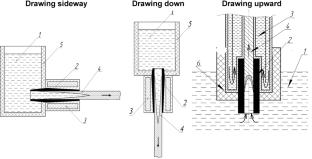Specific features of solidification of copper-phosphorus-alloy ingots produced by continuous upward casting
Abstract
We study specific features of solidification of cylindrical ingots with a diameter of 50 mm produced of copper-phosphorus alloys by continuous upward casting and intended for the hot extrusion of wire braze-alloy billets. The advantages and disadvantages of the procedure of continuous upward casting as applied to copper alloys are presented. We studied ingots of two alloys, namely, Cu‑7.2%P and Cu‑8.2%P. The Cu‑7.2%P alloy proves to be the most common two-component braze alloy for high-temperature brazing of copper and copper alloys. The Cu‑7.2%P alloy is eutectic and, hence, not suitable for brazing. We studied defects of ingots in the form of concentrated central cavities with wavy surfaces. It is shown that the formation of defects of this kind is possible only for the indicated type of continuous casting when the direction of ingot drawing is opposite to the direction of gravity. The mechanism of formation of the internal wavy surface of these defects is clarified. To prevent the appearance of these defects, it is necessary to create conditions under which the process of solidification of the ingot is completed below the level of the melt in the furnace. The structures of ingots were analyzed both in the longitudinal sections and in cross sections. It is shown that the macrostructure of the ingots of Cu‑8.2%P alloy is columnar. The phenomenon of spontaneous formation of the profile lines of solidification front in metallographic sections of the ingots of Cu‑8.2%P alloy was discovered. The formation of these lines is caused by two factors: the mode of step-by-step drawing and the nature of the alloy. The mode of step-by-step drawing leads to changes in the solidification conditions of the eutectic phases in the course of motion and during the shutdown. Specific features of solidification of the eutectic phases of copper-phosphorus alloys contribute to the formation of their different morphologies in the case where the solidification conditions are modified. The results of measuring of the sizes of dendrite cells in different parts of cross section of the ingot of Cu‑8.2%P alloy enable us to make a conclusion about the similar nature of solidification of the ingot of this alloy and an ingot of Cu‑8.2%P alloy under the identical casting conditions.


 求助内容:
求助内容: 应助结果提醒方式:
应助结果提醒方式:


